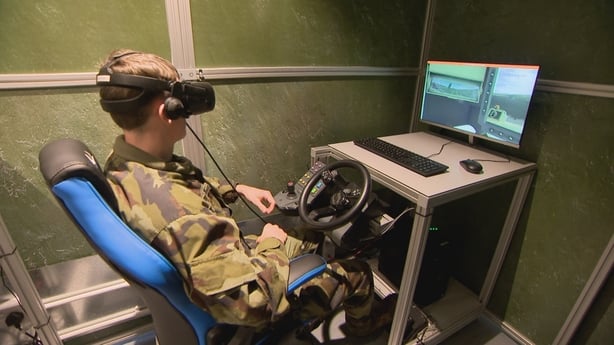The Defence Forces have announced plans to roll out virtual reality simulators to help train soldiers in regional locations.
Currently, the type of training only takes place in the military college in the Curragh but under the new plan it will be extended to two new locations in the next 12 months.
The new technology allows soldiers to hone their skills in various activities, including operating armoured personnel carriers and when calling in artillery fire in emergency situations.
The Defence Forces said the new methods are less costly, reduce real world errors and allows for more efficient use of equipment and weaponry.
Chief Instructor at the Cavalry School Commandant Joe Tynan said the new technology offers clear advantages.
"The advantage is we can make our soldiers perform better. It gives them more repetitions that they can do their job in a better way and it makes them safer...we can't just throw them in at the deep end. We need to progress their training. We need to develop them," he said.

Cmdt Tynan said the Defence Forces intend to roll out the technology outside of the military college in the Curragh.
"This will roll out to at least two more locations in the Defense Forces...where we see this going in the short term…is to make sure that we build in data analysis and data collection," he said.
He said this might include monitoring the heart rate of soldiers to see how they cope with stressful scenarios and optical analysis to see if they are correctly scanning the information in front of them.
Trooper Shane Doran said he found the virtual reality simulation for driving an armoured personnel carrier useful.
"The controls are identical to the ones in the actual car, and then all the inputs are the exact same. You can actually see everything moving, so it's identical to the real thing," he said.
Trooper Niall Freyne agreed and said: "You can get the practice of going through scenarios and figuring out what decisions you're going to make so that when it does come down to it, it's quicker."
At the Artillery school, Captain Brian Clarke said the new technology is used when learning how to call in artillery fire in emergency situations.
"Soldiers can make mistakes here, you'll see the error on the screen and with instructors, they learn how to rectify those errors, so that when they're practicing in the Glen of Imaal or anywhere else with live fire training, it's more cost-effective and it's more time efficient and they're conducting artillery procedures with less errors and with more accuracy," Cpt Clarke said.
Trooper Conor Hughes said this type of simulation involved a lot of calculations.
"It's more top-heavy in maths, so you've got to calculate bearings, distance, altitudes, all that sort of stuff," he said.
Trooper Anna May Stafford said virtual reality mitigated the effects of any errors "because if you miss a shot".
"It doesn't mean you've missed it. You just recalculate and go again," she said.






